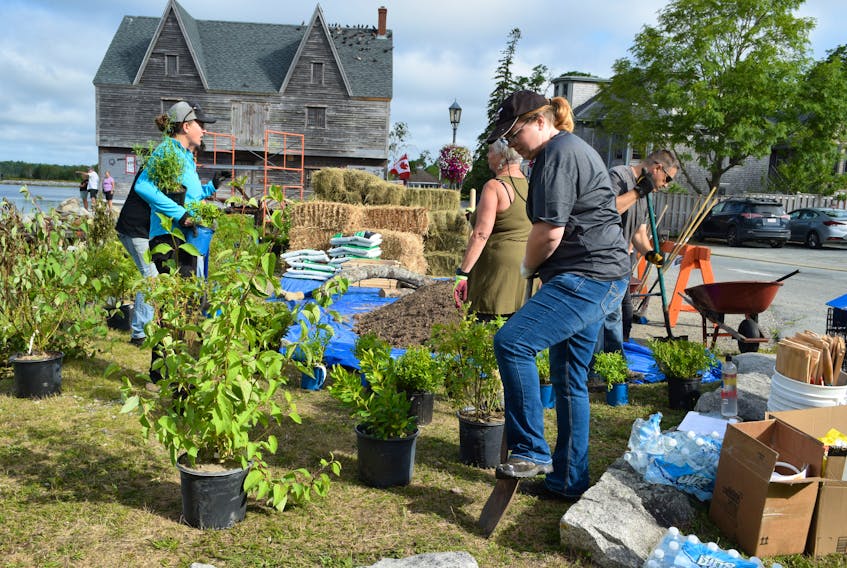SHELBURNE, N.S. — By KATHY JOHNSON
TRI-COUNTY VANGUARD
Vegetative buffers designed to help filter stormwater runoff and storm surge along the coast have been installed on Shelburne’s historic Dock Street through a joint project between the Town of Shelburne, the Bluenose Coastal Action Foundation and community volunteers.
In the works for more than a year, the vegetated buffer project is part of a larger stormwater management project Coastal Action is doing called the ‘Green Streets Stormwater Project’, a series of small-scale, nature-based infrastructure projects aimed at helping Nova Scotian communities and municipalities manage stormwater runoff and mitigate flooding, said Samantha Battaglia, project co-ordinator, stormwater management for the Coastal Action Foundation.
“Throughout the last two years we have sited, designed and installed 22 small-scale pieces of nature-based infrastructure, namely rain gardens and bioswales. Some of our project locations include the NSCC Lunenburg Campus, the South Shore Waldorf School, Mahone Bay Centre and, the Morton Centre,” said Battaglia.
Planting days for the Shelburne project were Aug. 17 and 18. Vegetative buffers were planted at the Bill Norman Park and one near the intersection of Dock Street and St. Andrews Lane.
The Dock Street and St. Andrew’s Lane buffer addresses erosion caused by both stormwater runoff from an upland area and storm surge along the coast, said Battaglia, while the buffers at Bill Norman Park are primarily addressing erosion issues from storm surge.
“The installation went smoothly with plenty of local volunteers of all ages and town staff helping dig, plant, and water the vegetated buffer, she said. “The town’s participation was integral in ensuring this project was a success. The town participated in the planning process, assisted us with the sourcing and delivery of materials” including bales, stakes, brush and logs, provided tools and labour and advertised the event in the Shelburne community.
The Dock Street and St. Andrew’s Lane buffer is a mix of native perennials, shrubs and structural elements such as logs, brush, and haybales and the two buffers along Bill Norman park are composed of native perennials and shrubs, said Battaglia.
“Overall the structural elements help protect the plants and slow the flow of runoff across the site. The plants themselves increase the absorption of stormwater runoff, protect the soil surface, and help anchor large volumes of soil with their root systems, stabilizing the soil along the coast.”
In total, 278 plants were planted, predominantly native perennials and shrubs that grow well in coastal environments that can tolerate periodic disturbance, moisture fluctuations and salt, said Battaglia. Low-bush blueberry, Atlantic aster, black-eyed Susan, white meadowsweet, wild rose, bayberry and red osier dogwood are among the species planted.
The Bluenose Coastal Action Foundation is celebrating its 25 anniversary this year.
“We deliver a number of projects throughout the region including fisheries research, water quality monitoring, fish habitat restoration, microplastics and marine debris research, and environmental education programs,” said Battaglia.
“We’re proud to deliver a wide variety of environmental projects and initiatives throughout the south shore region of Nova Scotia, most of which fall under our four main research areas: Coastal and Marine, Species at Risk and Biodiversity, Water Quality and Watersheds, and Climate Change and Education.”
The project was funded by the Intact Foundation, Bluenose Coastal Action and Environment and Climate Change Canada. The cost to the town was minimal and based mostly on volunteer/ in-kind labour hours.
Coastal erosion tackled on Shelburne’s Dock Street

STORY CONTINUES BELOW THESE SALTWIRE VIDEOS
Calling Chard: asparagus and leek risotto with chicken | SaltWire








